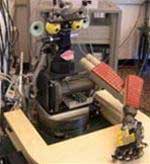 |
| Babybot learns by playing with objects – Photo: LIRA Laboratory, University of Genoa, Italy |
A robot capable of interacting with the world in a manner similar to that of a real human baby has been developed by scientists from France, Italy, and Switzerland. It offers researchers new insights into biological intelligence.
The robot, named Babybot, has the ability to autonomously experiment with objects in its vicinity and learn how to use them most effectively. This enables the robot to develop motor skills akin to those of a small child.
Babybot is a half-body robot equipped with one arm, eyes that are cameras, and a hand capable of grasping objects. It was designed to conduct experiments with items on a table in front of it and can evaluate forms of interaction, learning from trial and error.
For instance, if it fails to securely grasp an object, it will remember and attempt a different “strategy” in the next trial. One skill Babybot has learned is how to roll a bottle across the table. It can also “play” with a rubber duck or a ball.
The “brain” of Babybot is composed of 20 computers operating multiple neural networks. This software simulates biological neural systems and learning in a manner similar to humans—by establishing and altering the intensity of artificial nerve connections. By adjusting the neural network software and observing how the robot learns from its environment, robotic experts can test various scientific neural patterns.
“This is a brilliant idea. You can study the development of intelligence or artificial intelligence from this concept,” said Steve Grand, a robotics expert.
Scientists are preparing to build the next version of Babybot, named Robocub, which will resemble a newly walking toddler, expected to be completed by spring 2007.
KIM NHUNG




















































